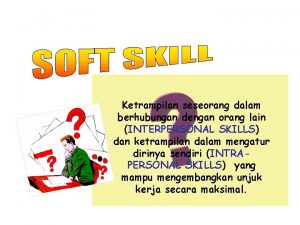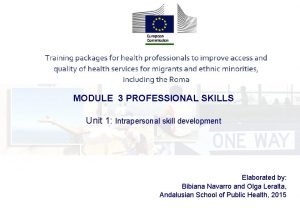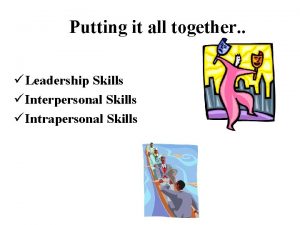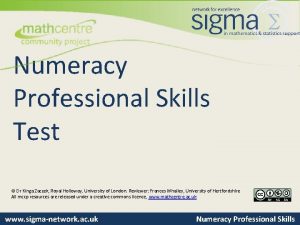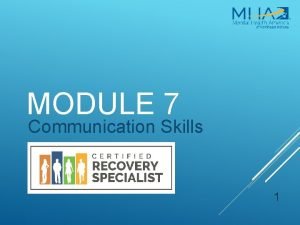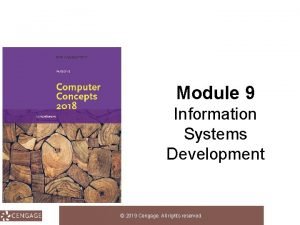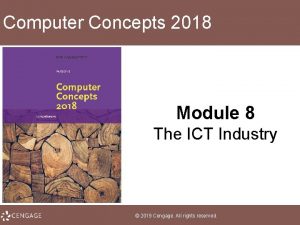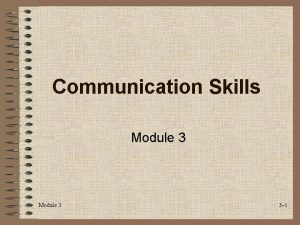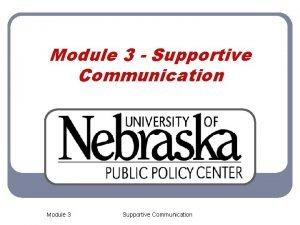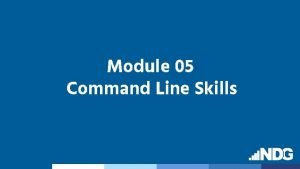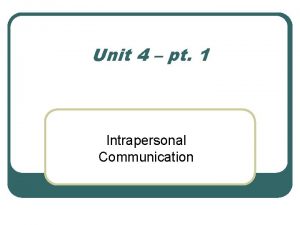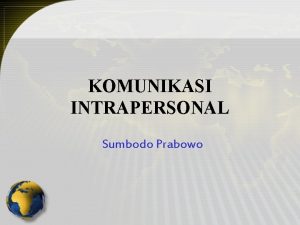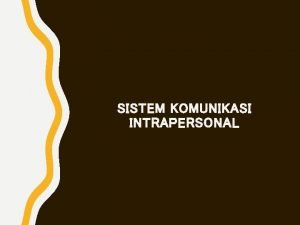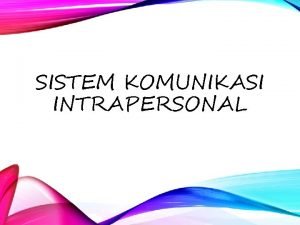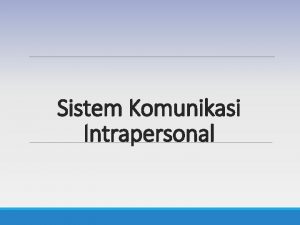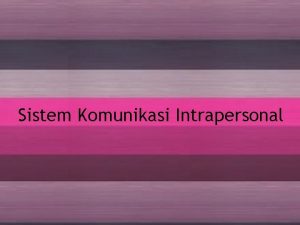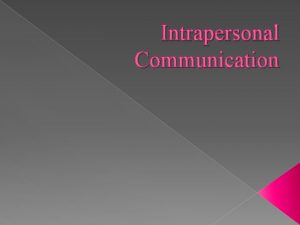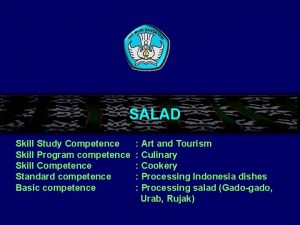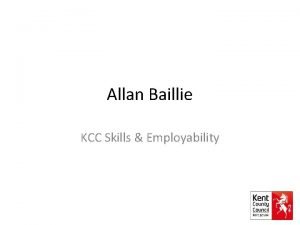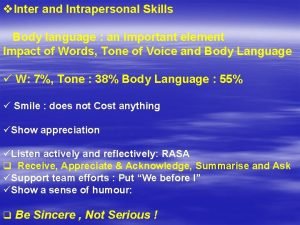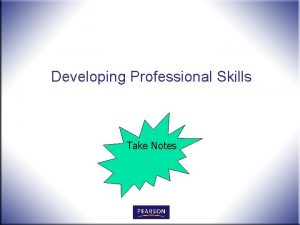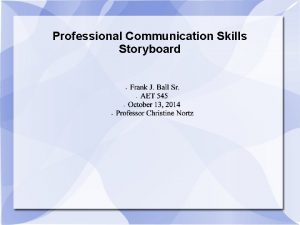MODULE 3 PROFESSIONAL SKILLS Unit 1 Intrapersonal skill



























- Slides: 27

MODULE 3 PROFESSIONAL SKILLS Unit 1: Intrapersonal skill development Elaborated by: Bibiana Navarro and Olga Leralta, Andalusian School of Public Health, 2015

Outline of the sesión • Activity 1: Confronting labels and stereotypes • Presentation: Intrapersonal skill development • Activity 2: Symbolic meanings of gestures • Presentation: Different meanings of gestures in other cultures: • Activity 3: Empathising with the patient • Activity 4: Reflective Listening • Activity 5: Confronting difficult situations and emotions (“Re-thinking”)

Objectives of the Presentation: • To identify key elements in communicating with migrants or ethnic minority patients. • To recognise techniques related to intrapersonal outcomes aiming to improving health professional-patient interaction in culturally diverse contexts. Objectives of the Activities: • To identify the role of stereotypes in communication with migrants and ethnic minorities • To identify communication and intrapersonal skills (empathy, active/reflective listening). • To acquire the ability to manage stress situations in the health professional -migrant/ethnic minority patients interaction

Activity 1: Confronting labels and stereotypes

Stereotypes, stigma and discrimination • Stereotypes are generalizations or assumptions that people make about the characteristics of all members of a group, based on an image (often wrong and always partial) about what people in that group are like and how they behave • Stereotypes lead to prejudices, stigma and discrimination • Stigma: adverse reaction to the perception of a negatively evaluated difference • Racism and discrimination strongly affect the health and well-being of those who suffer its consequences. Breslin and William (1991); Link, Bruce and Phelan (2001); Susman (1994)

Video Incompetent vs. Competent Cultural Care https: //www. youtube. com/watch? v=Dx 4 Ia-jat. NQ

Communication with a patient can be defined as: “specific tasks and observable behaviours that include interviewing to obtain a medical history as well as a patient's reason for the visit, discussing a diagnosis and prognosis, giving instructions on therapy and information needed for informed consent before undergoing any procedures, and counselling to motivate participation in treatment or to relieve symptoms” Duffy et al

• Research evidence indicates that there are strong positive relationships between a healthcare team member’s communication skills and a patient’s capacity to follow through with medical recommendations, selfmanage a chronic medical condition, and adopt preventive health behaviours. • Studies conducted during the past three decades show that the clinician’s ability to explain, listen and empathize can have a profound effect on biological and functional health outcomes as well as patient satisfaction and experience of care. IHC (2011); Mast (2015)

“A more people-centered and integrated approach to service delivery is expected to increase access to needed health services throughout the life-course; improve health and clinical outcomes; enhance continuity of care and satisfaction with services; expand participation of users and communities in their own health care; improve providers’ job satisfaction; reduce system inefficiencies and duplication of services; and facilitate intersectoral collaboration in order to address other WHO-WPRO (2007); WHO (2014) wider determinants of health. ”

Language seems at best tangential in communication research, unless it is assumed that language constitutes part of the process of message encoding and decoding that occurs during intercultural interaction. There is a continued interest in how nonverbal and verbal behaviour differ across cultures, concerning mainly what transpires in the immediate context of meaning or message transaction Holliday (2011)

Activity 2: Symbolic meanings of gestures

Nonverbal communication • Nonverbal behaviour has proved to be related to patient satisfaction • Nonverbal communication is unlikely to immediately affect patient physical or mental health. • Nonverbal aspects in the health professional-patient interaction play an important role, as interpersonal judgment relies mostly on nonverbal and appearance cues of the interaction. IHC (2011)

Health professionals can learn to monitor their own nonverbal behaviour to have a positive effect on patients: – Smiling, – eye-contact – leaning forward – expressive tone of voice and face – more nodding

Language barriers • Lack of fluency is a possible language barrier, but “for migrants, basic fluency in the language of the host country may not be enough to effectively communicate their health problem or understand what the health professional says”. • The essential features of healthcare communication rely on core communication skills, such as open-ended inquiry, reflective listening and empathy, as a way to respond to the unique needs, values and preferences of individual patients. Such skills are even more relevant in communication with migrant and ethnic minorities. (Stewart et al. , 2000)

Empathy • Psychological process that encompasses a collection of affective, cognitive, and behavioural mechanisms and outcomes in reaction to the observed experiences of another. • Sensitivity to different perspectives in communication. • Empathic processes affect how the health professional thinks and feels (intrapersonal outcomes), and behaves (interpersonal outcomes) with the patient. • The intrapersonal outcomes can be: – Affective (parallel and reactive emotions) – Non-affective Eric B. Larson, MD, MPH; Xin Yao, Ph. C (2005) Davis (1996)

Activity 3: Role Playing

Listening • Listening: active process in which senses, intellect and emotions operate. • Reflective listening in the health context: ability to capture what the patient is communicating then offering the message back to confirm the message has been understood correctly. • This technique facilitates the reaching of agreements, favours decisionmaking and obtaining answers, and it can help managing conflicts. Subiela (2014); IHC (2011)

Avoid distractions Interpret without changing the meaning Show respect about the patient’s feelings Note nonverbal cues emitted Not interrupt, show you are listening (yes, uhm, aha…) Empathise Keep eye contact, adequate tone of voice and posture Reflect the emotional state of the patient with words and nonverbal communication Summarise to avoid misunderstandings Ask only necessary questions Virshup BB, Oppenberg AA, Coleman MM (1999); Llacuna Morera J (2000); Rodriguez Bayón, A, Pérez Fuentes, F (1999); Mast MS (2007); Stephen G. Henry et al (2012)

Activity 4: Practicing Reflective Listening

Emotions and emotional self-control techniques • Emotions are inherent to the human being and are present in all aspects of our lives • Because our emotions affect our actions: to have an adequate level of emotional management skills in order to: – Provide a better service – Feel better Cadman and Brewer (2001)

Emotional intelligence 1. Knowing one’s emotions 2. Managing emotions 3. Self-motivation 4. Recognizing emotions in others 5. Handling relationships. Cadman C, Brewer J. (2001); Goleman, D. (1996); Mc. Garty, Craig; Yzerbyt, Vincent Y. ; Spears, Russel (2002)

Cognitive dissonance and automatic thoughts • Relevant as they influence our thoughts, feelings and behaviour. • Labelling and stereotypes are examples of automatic thoughts. • To detect these dissonances and to re-think Mc. Garty et al. (2002)

Activity 5: Confronting difficult situations and emotions (“Re-thinking”)

Thank you and questions … Pictures: Andalusian Childhood Observatory (OIA, Observatorio de la Infancia de Andalucía) 2014; Josefa Marín Vega 2014; Red. Isir 2014; Morguefile 2014.

References Breslin, J. William. (1991). "Breaking Away from Subtle Biases" in Negotiation Theory and Practice, eds. J. William Cadman C, Brewer J. (2001). Emotional intelligence: A vital prerequisite for recruitment in nursing. J Nurs Manag. 9: 321– 4. Davis MH. Empathy: A Social Psychological Approach. Boulder, Colo: Westview Press; 1996 Duffy FD, Gordon GH, Whelan G, Cole-Kelly K, Frankel R, Buffone N et al. Assessing competence in communication and interpersonal skills: the Kalamazoo II report. Acad Med 2004; 79: 495 -07. Eric B. Larson, MD, MPH; Xin Yao, Ph. C (2005). Clinical Empathy as Emotional Labor in the Patient-Health professional Relationship. JAMA. 2005; 293(9): 1100 -1106 available at: HUhttp: //jamanetwork. com/article. aspx? articleid=200456 UH (retrieved January 20, 2015) Goffman, Erving. (1963). Stigma: Notes on the Management of Spoiled Identity. Englewood Cliffs, NJ: Prentice Hall. Goleman, D. (1996). Emotional Intelligence (London 1996) Holliday, A. (2011) Intercultural Communication and Ideology. London: Sage IHC (2011). Impact of Communication in Healthcare. Available at HUhttp: //bit. ly/1 o 6 n. HGin. UH (retrieved: January 19, 2015) Link, Bruce and Jo Phelan. (2001). “Conceptualizing Stigma. ” Annual Review of Sociology 27: 363– 85. Llacuna Morera J. La comunicación no verbal (I): ¿cómo interpretar los gestos de nuestro interlocutor? . Formación Médica Continuada. 2000; 9: 576 -87. Mast MS. On the importance of nonverbal communication in the physician-patient interaction. Patient Educ Couns. 2007; 67: 3158. available at http: //www. sciencedirect. com/science/article/pii/S 0738399107000973 (retrieved January, 21 2015) Mc. Garty, Craig; Yzerbyt, Vincent Y. ; Spears, Russel (2002). HU"Social, cultural and cognitive factors in stereotype formation"UH. Stereotypes as explanations: The formation of meaningful beliefs about social groups. Cambridge: HUCambridge University Press. UH. pp. 1– 15.

References Rodriguez Bayón, A, Pérez Fuentes, F. Escuchar, algo más que oir. Formación Médica Continuada en Atención Primaria. Vol 6. Núm. 10. Diciembre 1999. Stephen G. Henry et al (2012) Association between nonverbal communication during clinical interactions and outcomes: A systematic review and meta-analysis. Patient Educ Couns. 2012; 86: 297– 315 available at HUhttp: //www. sciencedirect. com/science/article/pii/S 0738399111003739#UH (retrieved January, 21 2015) Subiela García, JA et al. La importancia de la Escucha Activa en la intervención Enfermera. Enfermería Global, nº 34, Abril 2014. Susman, Joan. 1994. “Disability, Stigma and Deviance. ” Social Science and Medicine 38: 15– 22. Stewart M, Brown J, Donner A, et al. (2000). The impact of patient-centered care on outcomes. J Fam Pract. ; 49: 805 -807 Virshup BB, Oppenberg AA, Coleman MM. Strategic Risk Management: Reducing Malpractice Claims Through More Effective Patien-Doctor Communication. American Journal of Medical Quality 1999; 14(4): 153 -9. WHO-WPRO, World Health Organization, West Pacific Region Office. People-Centred Health Care: A policy framework. Geneva: WHO, 2007. http: //www. wpro. who. int/health_services/people_at_the_centre_of_care/documents/ENG-PCIPolicy. Framework. pdf (retrieved: January 12, 2015). WHO, World Health Organization. WHO Global Strategy on People-Centred and Integrated Health Services. Geneva: WHO, 2014.

 Intra personal skill
Intra personal skill Contoh hard skill
Contoh hard skill Difference between interpersonal and intrapersonal
Difference between interpersonal and intrapersonal Intrapersonal skill
Intrapersonal skill What is a soft skill
What is a soft skill Intrapersonal skills
Intrapersonal skills Soft skills development ppt
Soft skills development ppt C device module module 1
C device module module 1 Conceptual selling techniques
Conceptual selling techniques Literacy professional skills test
Literacy professional skills test Professional skills test numeracy
Professional skills test numeracy The trend in professional selling today is
The trend in professional selling today is Oral communication module 7
Oral communication module 7 Basic employability skills nccer
Basic employability skills nccer Nccer basic employability skills
Nccer basic employability skills Module 5 computer concepts skills training
Module 5 computer concepts skills training Module 10 computer concepts exam
Module 10 computer concepts exam Module 8 computer concepts skills training
Module 8 computer concepts skills training Module 3 communication/interpersonal skills
Module 3 communication/interpersonal skills Module 00107-15 exam basic communication skills answers
Module 00107-15 exam basic communication skills answers Basic communication skills module 7
Basic communication skills module 7 Module 8: basic employability skills
Module 8: basic employability skills Supportive communication examples
Supportive communication examples Module 5 - command line skills
Module 5 - command line skills Unit 6 review questions
Unit 6 review questions Ontario skills passport
Ontario skills passport Lpmde
Lpmde Professional ethics unit 1 notes
Professional ethics unit 1 notes

